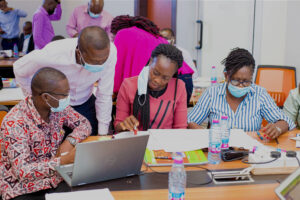Let’s Talk about the Future of Public Participation in OGP
Hablemos del futuro de la participación pública en OGP
Public participationGiving citizens opportunities to provide input into government decision-making leads to more effective governance, improved public service delivery, and more equitable outcomes. Technical specificatio... is at the heart of OGP, so it was no surprise that it was a frequent topic across community conversations during the consultations for the new OGP strategy. The message was clear: OGP needs to rethink its approach to public participation, but what does that mean in practice?
The IRM analyzed 106 commitments that achieved significant changes in public participation government practices. These include commitments that created forums, mechanisms, or processes that consulted or allowed the public to provide feedback on specific policies or report on specific community issues. While their impact was a positive step forward the vast majority of the commitments tended to be one-off developments and did not leave a lasting legacy of institutionalized, binding, or sustainable changes.
To help us reflect and think through some of our findings we turned to two experts and long-time friends of the IRM: Anabel Cruz and Cesar Nicandro Cruz. Anabel (the current OGP Steering CommitteeThe Steering Committee is OGP’s executive decision-making body. Its role is to develop, promote and safeguard OGP’s values, principles and interests; establish OGP’s core ideas, policies, and ru... co-chair) and Cesar (a member of the IRM’s International Experts Panel) were both part of the first generation of IRM researchers.
How can OGP shift the focus from one-off developments to institutionalized approaches of public participation?
Anabel: We need to start talking of open public society, not just as an ad-hoc feature or an ornament, but as an integral part of the process. It’s not easy because we have to change the whole culture of government, the culture of public offices, and the culture also of civil society organizations.
Cesar: Offering alternatives (of participation) is not the same as promoting processes towards change and improvements on the basis of more inclusive and qualitative participation which is why I think we could use the new strategy to change OGP’s incentives, some rules and reimagine our main narrative in terms of public participation.
How can OGP support scaling one-off practices to transcend to the whole of government?
Anabel: There are very good examples of public participation across the world. But they are somewhat scattered, and fragmented. There is not yet a system, probably of learning, and taking into account all of those practices and replicating them in some form.
Cesar: Successful public participation practices can be scaled but it will not necessarily imply more openness if public participation continues to be seen as an accessory to commitments and not a foundational ingredient in a strategy to open government. The main idea here is to value innovation and learning and offer tools to support these processes.
What more can be done to make public participation a cross-cutting backbone that permeates through all that OGP does?
Anabel: For that, two things are crucial. One is about the importance of resources, about the importance of resourced, strong, accountable organizations. The other crucial element, I think, is the protection of civic space. It’s clear that open civic space is an enabling environment for real public participation processes. OGP has the opportunity to work with international, national, and local actors in both the public and private sectors to counteract the shrinking civil space trend. Probably, more robust national and local plans in terms of the protection of civic space and the protection of human rightsAn essential part of open government includes protecting the sacred freedoms and rights of all citizens, including the most vulnerable groups, and holding those who violate human rights accountable. T... can help reverse these trends. If we don’t have an open civic space and an open environment, OGP cannot realize its mission and public participation will lose all meaning.
Cesar: We should encourage public participation beyond action plans, beyond the co-creation processCollaboration between government, civil society and other stakeholders (e.g., citizens, academics, private sector) is at the heart of the OGP process. Participating governments must ensure that a dive... and multi-stakeholder forums (MSFs). This means promoting progress in existing legal frameworks, in institutional structures, creating opportunities for capacity buildingEnhancing the skills, abilities, and processes of public servants, civil society, and citizens is essential to achieving long-lasting results in opening government. Technical specifications: Set of ac..., and opening up participation in new or existing spaces in other policy areas. Let’s also keep in mind that OGP MSFs are a successful democratic innovation whose concept, promotion, and improvements have been led by and for OGP. So it’s no longer about governing for people, but instead with people. If this is not a clear shift for OGP and for the member governments, the strategy will not be successful.
How do you see the IRM in the next five years?
Anabel: In terms of research and in terms of generating solid and relevant data, I think the IRM is one of the most important things we have. Keep up the good work! I think the IRM is a chain of solid links that connect the entire OGP process.
Cesar: The IRM should be seen as a place of learning and accountability, but above all as a way of working that enables us to protect the partnership, and allows us to defend OGP’s work based on experience and comparable knowledge. I also think it has been a fundamental element to improve OGP processes and action plans.
La participación pública está en el corazón de OGP, así que no fue sorpresa que este tema surgiera constantemente en los diálogos comunitarios que se realizaron durante la etapa de consulta de la nueva estrategia. El mensaje fue claro: OGP necesita replantear su enfoque de participación pública. Pero, ¿qué significa esto en la práctica?
El IRM realizó un análisis de 106 compromisos que han sido evaluados como “significativos” o “excepcionales” por los cambios en la práctica gubernamental de participación pública. Estos son compromisos que crearon foros, mecanismos o procesos de consulta que permitieron al público ofrecer retroalimentación sobre políticas públicas específicas o reportar problemas comunitarios. Sin embargo, la mayoría de estos compromisos fueron acciones aisladas y su impacto, aunque positivo, no dejó un legado de cambios institucionalizados o sostenibles en el tiempo.
Para ayudarnos a reflexionar sobre nuestros hallazgos recurrimos a dos expertos y viejos amigos del IRM. Anabel Cruz, co-presidenta del Comité Directivo, y Cesar Nicandro Cruz, miembro del Panel de Expertos Internacionales del IRM. Ambos comparten algo muy especial en sus trayectorias en gobierno abierto: formaron parte de la primera generación de investigadores IRM.
¿Cómo puede OGP fomentar un cambio de enfoque de acciones puntuales de participación a la institucionalización de la participación pública?
Anabel: Necesitamos empezar a hablar de una sociedad pública abierta, no sólo como un aspecto accesorio, sino como una parte integral del proceso. No es fácil porque para ellos es necesario cambiar la cultura del Gobierno, de las oficinas públicas y la cultura de las organizaciones de sociedad civil.
Cesar: Ofrecer alternativas no es lo mismo que impulsar procesos de cambio sobre la base de una participación pública inclusiva y de calidad. Por ello podríamos modificar el esquema de incentivos, cambiar algunas reglas, la narrativa principal y los mensajes que desde OGP se envían en esta materia.
¿Cómo puede OGP apoyar a replicar las prácticas puntuales de participación para que trasciendan a todo el Gobierno?
Anabel: Hay muy buenas prácticas de participación pública en todo el mundo pero están dispersas y no existe un sistema de aprendizaje que las tome en cuenta y que sea replicable.
César: Prácticas de participación pública exitosas podrían escalarse y generalizarse, pero ello no implicaría un mayor beneficio global (o incluso eficacia en términos de apertura) si la participación pública sigue siendo vista como complemento dentro de los compromisos, antes que como un ingrediente fundacional de una estrategia genuina de apertura. La idea central sería valorar la innovación, el aprendizaje y brindar herramientas para apoyar estos procesos.
¿Qué más podemos hacer para que la participación pública sea un eje transversal en la nueva estrategia de OGP?
Anabel: Hay dos factores clave: la importancia del acceso a los recursos para que existan organizaciones fortalecidas y que rinden cuentas, y la protección del espacio cívico. Está claro que un espacio cívico abierto facilita las condiciones para que existan procesos de participación pública efectivos. OGP tiene la oportunidad de trabajar en conjunto con actores internacionales, nacionales y locales tanto en el ámbito público como privado para contrarrestar la tendencia de ir cerrando el espacio cívico. Probablemente planes de acción más robustos en términos de protección del espacio cívico y derechos humanos pueden ayudar a revertir esta tendencia. Si no tenemos un espacio cívico abierto OGP no puede realizar su misión y la participación pública perdería todo su significado.
César: Debemos promover que los gobiernos impulsen la participación pública desde OGP más allá de los planes de acción, del proceso de cocreación y de los foros multiactor. Esto exige promover avances desde la normativa y estructuras institucionales en la creación de capacidades, pero también desde la apertura de nuevos o existentes espacios a otras agendas transversales. Hay que recordar que los foros multiactor impulsados por OGP son una innovación democrática exitosa, cuya conceptualización e impulso se han liderado por y desde OGP. Ya no se trata de “gobernar para las personas”, sino “gobernar con ellas”. Y si no se tiene claro esto desde el principio, tanto para OGP como para los Gobiernos participantes, se fallará en la estrategia OGP.
¿Cómo ven el papel del IRM en los próximos cinco años?
Anabel: En términos de investigación y de generación de datos sólidos y relevantes, creo que el IRM es una de las cosas más importantes que tenemos. ¡Sigan con el buen trabajo! Me parece que es una cadena de eslabones sólidos que conecta todo el proceso de OGP.
Cesar: El IRM debe entenderse desde una instancia de aprendizaje y de rendición de cuentas, pero sobre todo cómo una forma de trabajo que nos permite blindar a esta plataforma internacional y defenderla desde la base de la experiencia y del conocimiento contrastable. Yo creo que además ha servido como un elemento fundamental para mejorar procesos y ciclos de planes de acción.
No comments yet
Related Content

2022 IRM Week
Explore content co-created with the wider IRM community that spotlights insights on country performance and thematic priorities to ensure strategic use of IRM findings.
 Challenges and Solutions
Challenges and Solutions Six Questions to Protect Your Transparency Portal from “Zombie” Status
Have you ever searched an online government transparency portal only to find that the vital information you hoped to find is not there or that the portal itself has disappeared?…
 Challenges and Solutions
Challenges and Solutions 

Leave a Reply